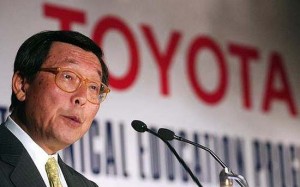
Though it could soon outsell GM in the key U.S. market, Toyota has plenty of challenges ahead, according to its top U.S. executive, Yoshimi Inaba.
Toyota’s top executive in the United States says the Japanese auto giant expects to lose money in North America even as it prepares to sell more cars in the United States than a restructured General Motors Corp.
Yoshimi Inaba, the new president and chief operating officer of Toyota Motor America and chairman, and CEO of Toyota Motor Sales USA, said he hopes the company’s North American operations can return to profitability during its next fiscal year, which begin in April 2010.
“It’s a challenge. I guess I’ve just set myself a very big goal,” he said, during a meeting with reporters in Detroit. “Our strength is our ability to meet local needs. “I don’t see how Toyota can be profitable again without being profitable in the North America,” he said.
Inaba, who was invited to rejoin Toyota after a two year-stint as president of Central Japan International Airport Co., Ltd. in Nagoya, Japan, also said it is quite likely that Toyota could emerge as the top car seller in the United States if the predictions that General Motors is destined to lose market share prove accurate.
(GM has projected its share would drop from about 20%, currently, to somewhere at or below 18.5%.)
“Toyota tried very hard to become number one,” as it doubled sales world wide in the last eight years. However, the rapid growth also created problems, leaving Toyota vulnerable when sales dropped simultaneously in the U.S., Japan and Western Europe.
That comment is particularly noteworthy in that over the last several years, as the Japanese giant started catching up to its American arch-rival, it repeatedly insisted that becoming the world’s largest carmaker was notably not one of its goals.
Toyota has a number of challenging issues to deal with in a market that has long been a source of profit, pride and continuous growth. As things stand, Inaba said the automaker will not continue its contract with New United Motor Manufacturing Inc., its long-standing joint venture with General Motors. GM recently announced that, as it is abandoning the Pontiac brand, it will no longer need the Vibe crossover produced at the Northern California facility, and will itself withdraw from the 50-50 joint venture.
However, Inaba declined to say whether Toyota would shut down the NUMMI assembly plant in Fremont, Calif. “We are looking at the viability of NUMMI. (But) there is a likelihood that we would not buy the rest of NUMMI (from GM,)” he said.
“There are a number of difficult and complex issues that we need to address before making any final decisions with respect to NUMMI and this process will take more time,” Inaba said.
The plant employs more than 5,400 and is now the only automotive assembly plant operating in California or anywhere else on the West Coast. It also is Toyota’s only unionized plant in the U.S. The United Auto Workers has confirmed it is now in negotiations with Toyota in hopes of finding a way to keep NUMMI open.
Inaba predicted auto sales in the U.S. will take time to recover. However, they will recover, he said. “There is a little pulse in the market. The market can’t get any worse,” he said, unlike in Japan. “Public transportation is very well developed (there). In the U.S., the situation is quite different. We can still be very excited about this market,” he said.
Inaba said Toyota is committed to creating cars which people with fall in love. That is a challenge, considering the recent APEAL report, an annual study of what excites American consumers about the vehicles they buy. The research firm, J.D. Power and Associates found that European and, to a lesser degree, American, makers lead the industry in terms of such surprise-and-delight factors. Toyota, on the other hand, ranked near the bottom of the industry.
Inaba acknowledged it’s getting tougher to woo American consumers. “We see what many, many of our competitors are doing,” Inaba said. “They are doing a good job of catching up,” added Inaba, who said the gap will probably continue to narrow. Toyota, however, also continues to improve the quality of its vehicles. “Our warranty costs are going down,” he noted.
Some analysts question whether Toyota can continue to maintain its position as the industry’s “green” leader. It took a hit, recently, when Ford launched the Fusion hybrid, which delivers 4 mpg better mileage than the comparable Toyota Camry Hybrid. And while the Toyota Prius has regained some momentum since the launch of the third-generation Prius, earlier this year, the hybrid’s volumes are still lagging far back from year-ago levels, when they peaked at more than 20,000 a month.
Now, GM hopes to take on Toyota in the green market with the upcoming Volt plug-in hybrid, while Nissan and Ford are getting ready to roll out dedicated battery-electric vehicles. Toyota plans to test-market a plug-in version of Prius but is refusing to commit to a retail version or to a pure battery car.
It will take another five years for pure electric vehicles to reach the mainstream for the motoring public in the United States, Inaba insisted, adding that the necessary battery technology simply isn’t ready.
TheDetroitBureau.com’s Bureau Chief Paul A. Eisenstein contributed to this report.
